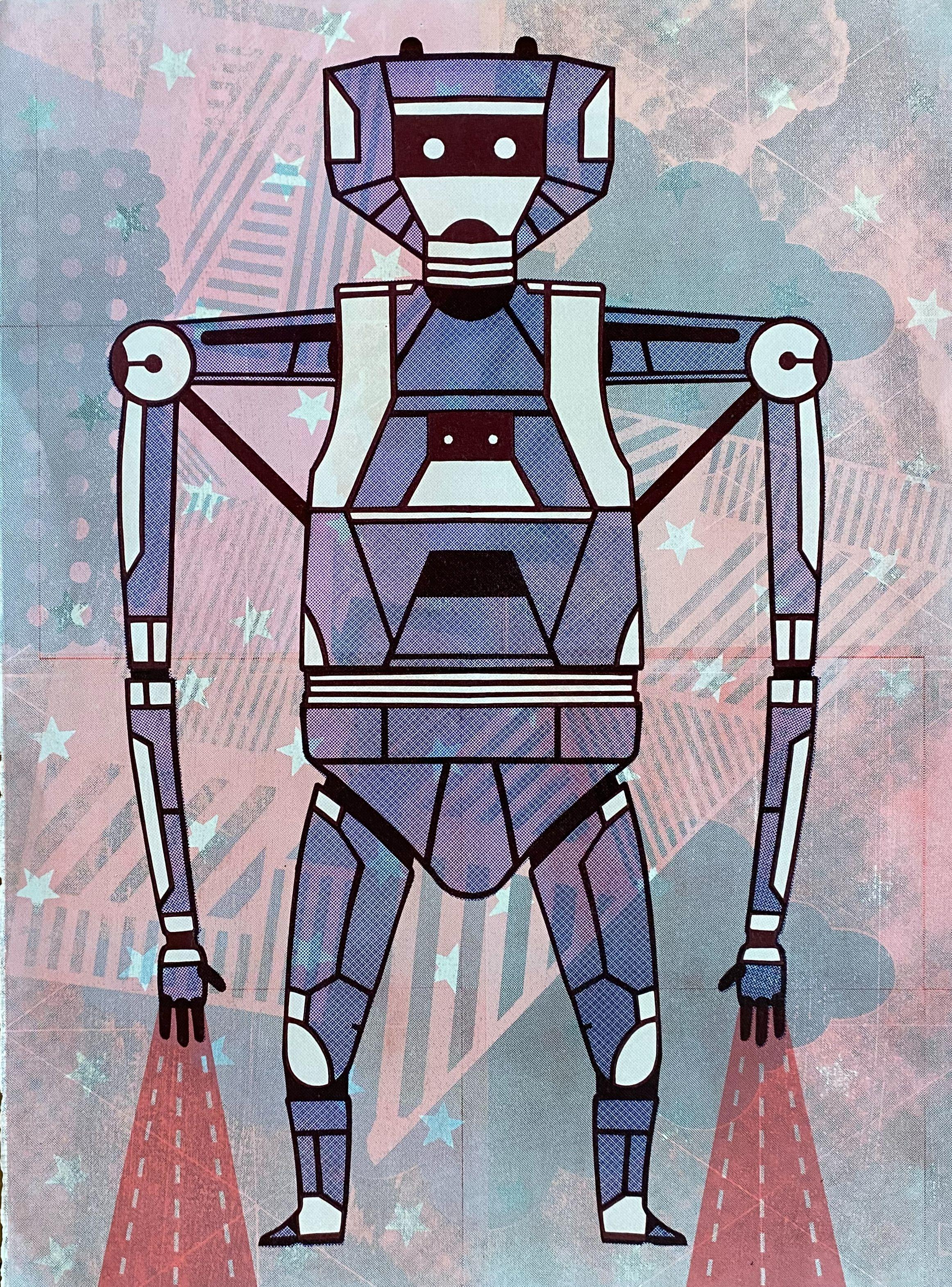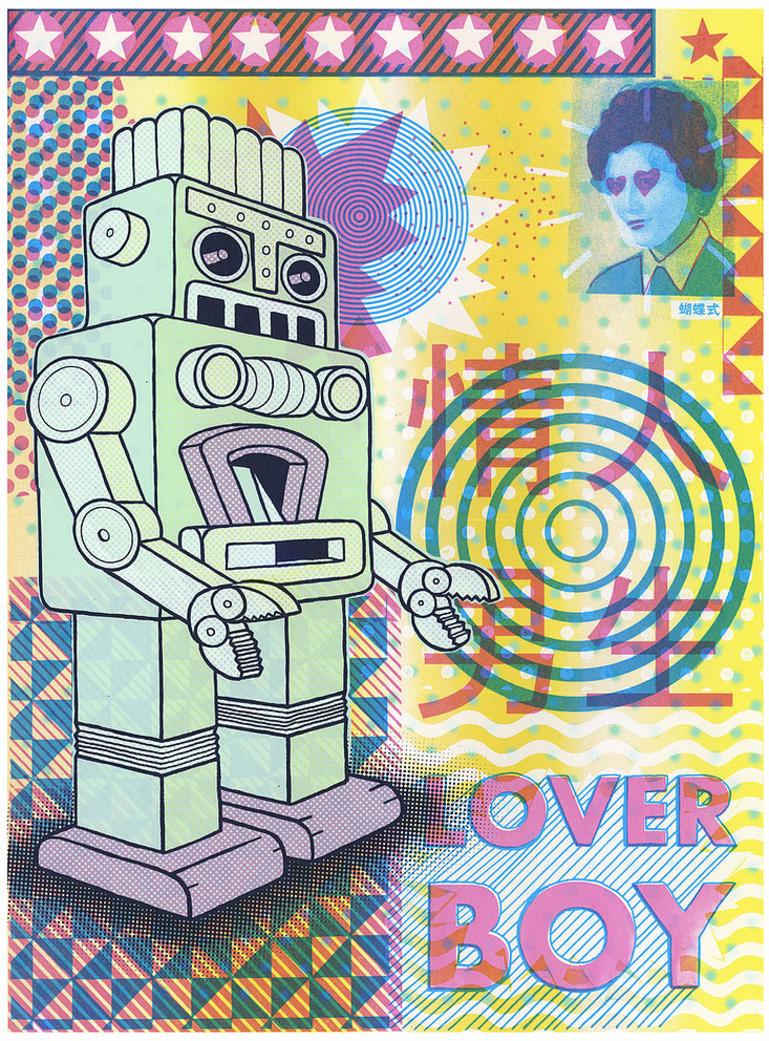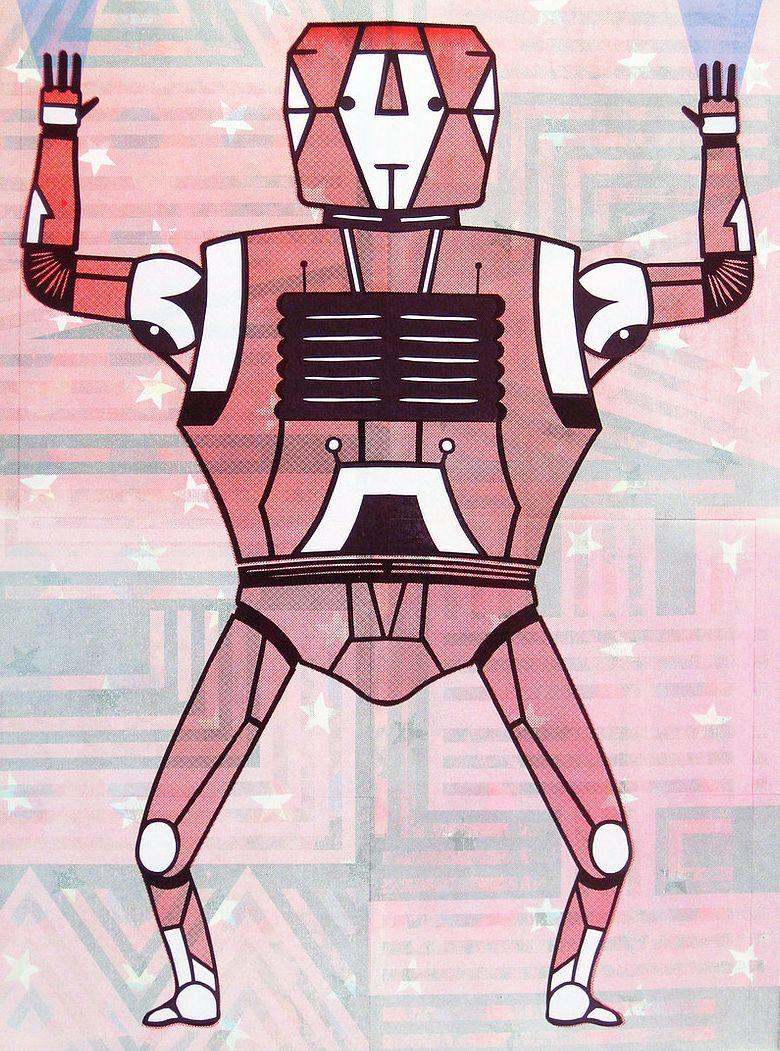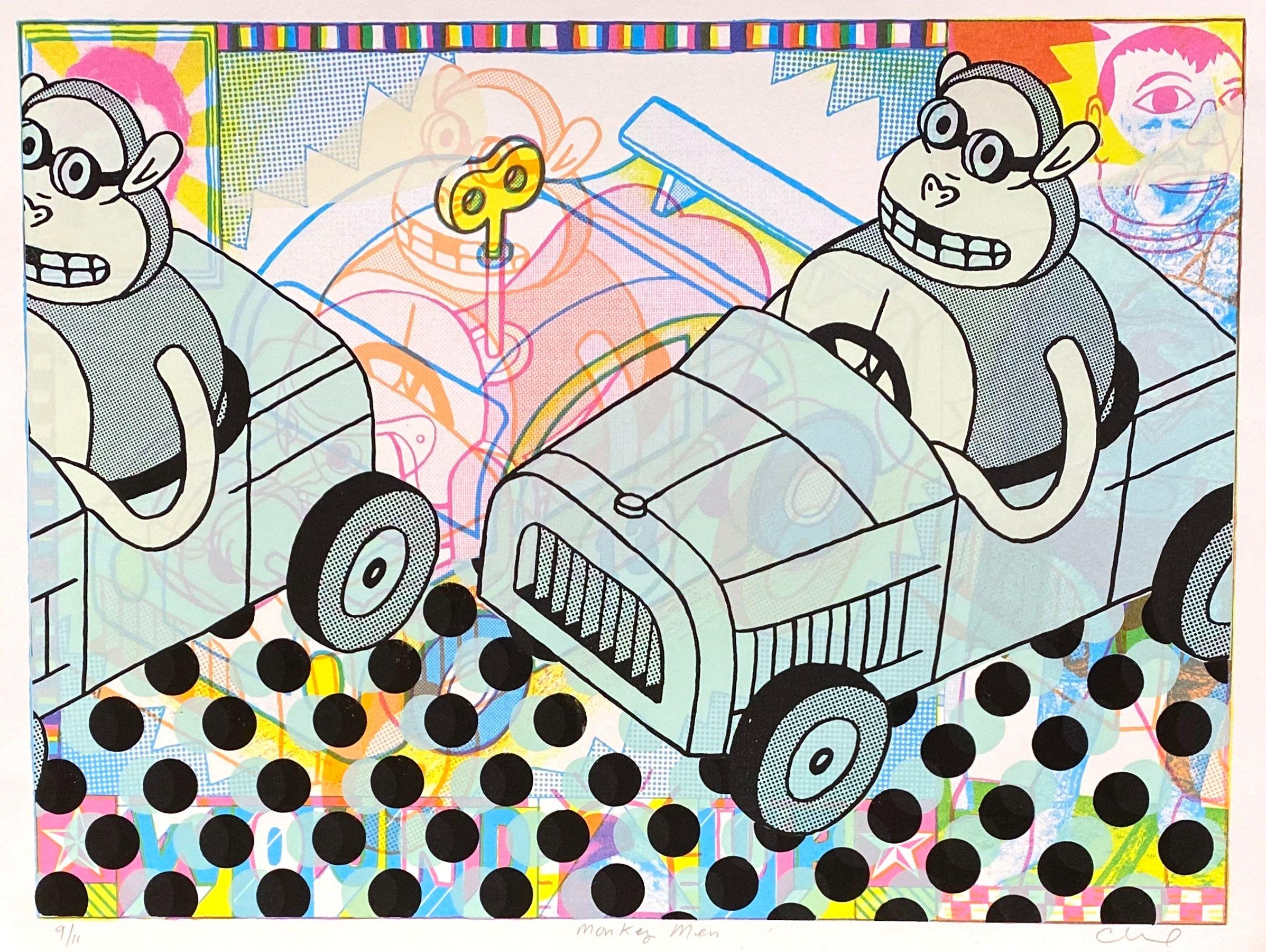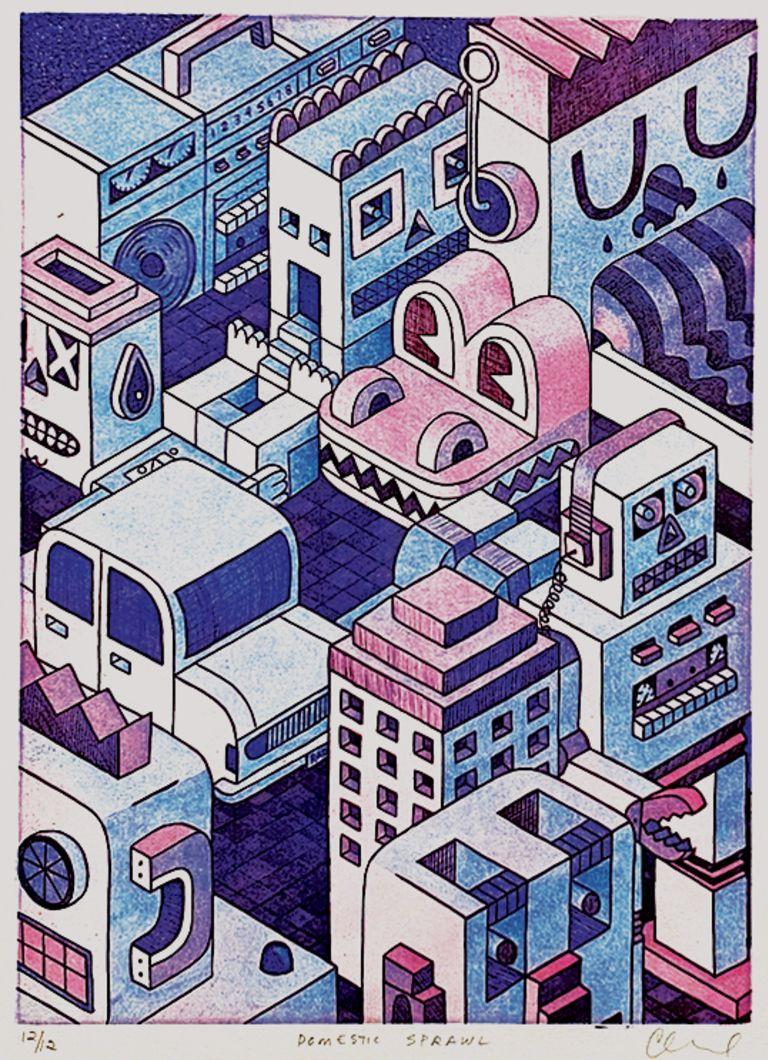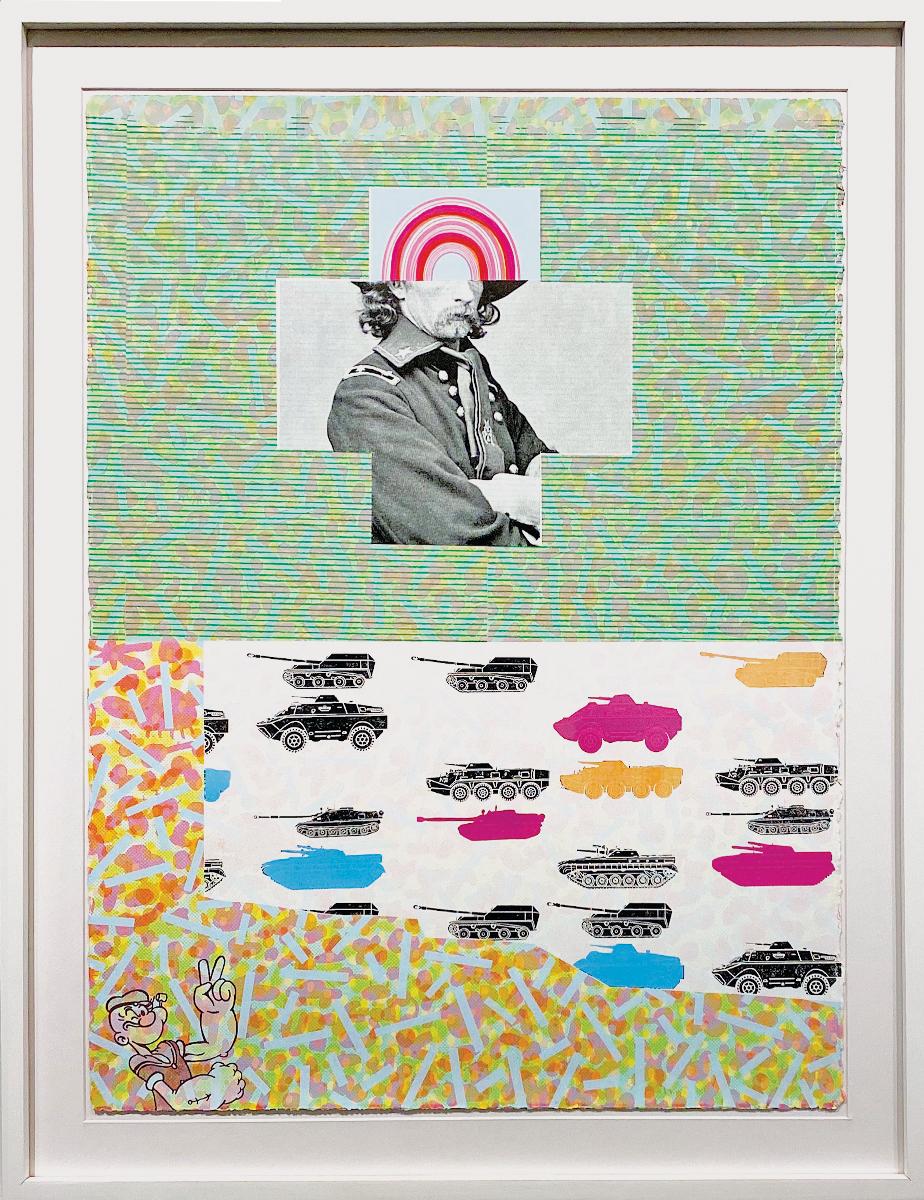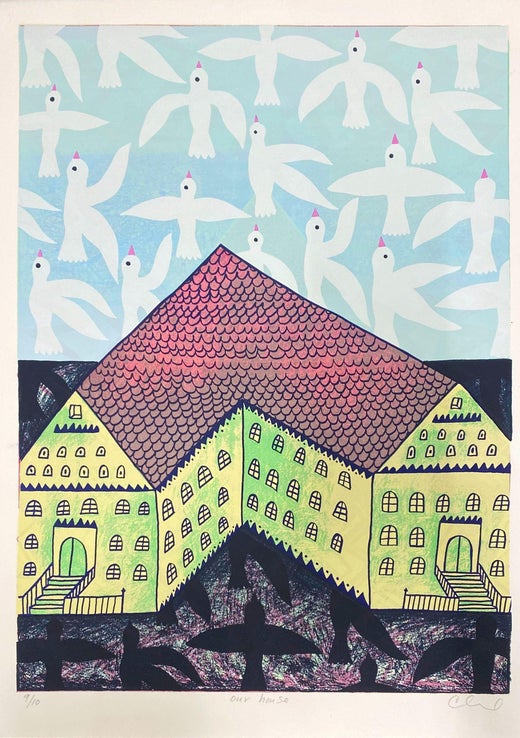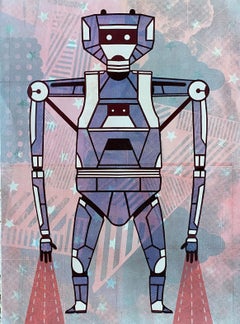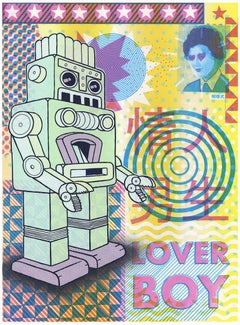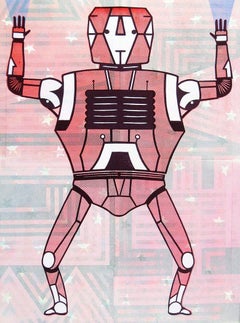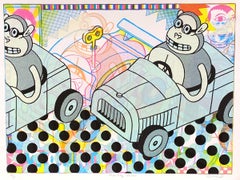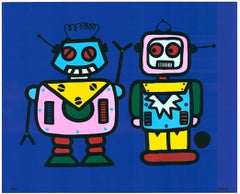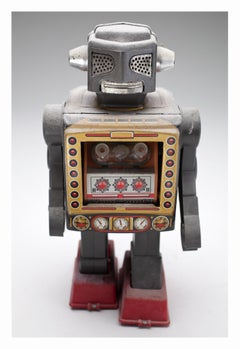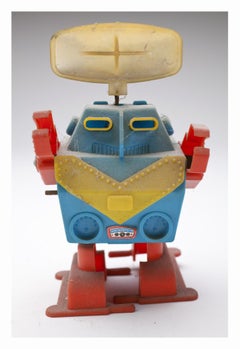Want more images or videos?
Request additional images or videos from the seller
1 of 5
Chadwick TolleyRobot Boy (6/8 II)
$175
£135.95
€154.25
CA$250.22
A$273.74
CHF 142.97
MX$3,271.30
NOK 1,796.24
SEK 1,690.54
DKK 1,151.92
About the Item
“I am interested in art that suggests a narrative,” says artist Chadwick Tolley. While he uses his personal experience as a point of reference for his prints, drawings, and collages, his work is not intended to be autobiographical.
“I hope that by examining my own experience, I can connect or relate to something universal,” says Tolley.
Each piece begins as an idea or desire to explore one of the many technical aspects of printmaking. Tolley starts by collecting images, sketches, and textures and then layers them to create the final composition. He avoids planning ahead and instead intuitively responds to the images as they emerge deliberately leaving behind evidence of deletions, corrections, and other marks as a documentation of the process.
Tolley exhibits widely across the United States and has won various awards for his work. His work is also included in several public collections in the United States, the Guangdong Museum of Art in China, and the Jordanian National Gallery of Art in Amman, Jordan. He also teaches Printmaking and Drawing at Augusta University in Augusta, Georgia.
- Creator:Chadwick Tolley
- Dimensions:Height: 21 in (53.34 cm)Width: 15 in (38.1 cm)
- Medium:
- Movement & Style:
- Period:
- Framing:Framing Options Available
- Condition:
- Gallery Location:Nashville, TN
- Reference Number:1stDibs: LU1675211272012
undefined
About the Seller
5.0
Vetted Professional Seller
Every seller passes strict standards for authenticity and reliability
Established in 2020
1stDibs seller since 2021
57 sales on 1stDibs
- ShippingRetrieving quote...Shipping from: Nashville, TN
- Return Policy
More From This Seller
View AllOwen (2/5)
Located in Nashville, TN
“I am interested in art that suggests a narrative,” says artist Chadwick Tolley. While he uses his personal experience as a point of reference for his prints, drawings, and collages,...
Category
2010s Contemporary Prints and Multiples
Materials
Screen
E-Love (6/10)
Located in Nashville, TN
“I am interested in art that suggests a narrative,” says artist Chadwick Tolley. While he uses his personal experience as a point of reference for his prints, drawings, and collages,...
Category
2010s Contemporary Prints and Multiples
Materials
Screen
Nixon (1/5)
Located in Nashville, TN
“I am interested in art that suggests a narrative,” says artist Chadwick Tolley. While he uses his personal experience as a point of reference for his prints, drawings, and collages,...
Category
2010s Contemporary Prints and Multiples
Materials
Screen
Monkey Men (1/11)
Located in Nashville, TN
“I am interested in art that suggests a narrative,” says artist Chadwick Tolley. While he uses his personal experience as a point of reference for his prints, drawings, and collages,...
Category
2010s Contemporary Prints and Multiples
Materials
Screen
Domestic Sprawl (11/12)
Located in Nashville, TN
“I am interested in art that suggests a narrative,” says artist Chadwick Tolley. While he uses his personal experience as a point of reference for his prints, drawings, and collages,...
Category
2010s Contemporary Prints and Multiples
Materials
Screen
Peace Man
Located in Nashville, TN
“I am interested in art that suggests a narrative,” says artist Chadwick Tolley. While he uses his personal experience as a point of reference for his prints, drawings, and collages,...
Category
2010s Contemporary Prints and Multiples
Materials
Screen
You May Also Like
Roboter
By Franz Basdera
Located in Winterswijk, NL
Giclée on Hahnemühle Velvet
2021
Hand signed and numbered
Edition: 20
Category
21st Century and Contemporary Paintings
Materials
Giclée
$462 Sale Price
20% Off
Untitled (from ROBOTNICS Series)
By Christian Rothmann
Located in Kansas City, MO
Christian Rothmann
ROBOTNICS Series
C-Print
2019
Edition S (Edition of 10)
12 x 8.3 inches (30.5 x 21 cm)
Signed, dated and numbered verso
Other Edition Sizes available:
- Edition ...
Category
2010s Pop Art Photography
Materials
C Print
Oscar the Robot, Pop Art Print by Van Hoeydonck
Located in Long Island City, NY
This is an original silkscreen from the Licht Calendar portfolio by Paul van Hoeydonck, unsigned from the edition of 3000.
Oscar the Robot by Paul van Hoeydonck, Belgian (1925)
Port...
Category
1970s Pop Art Figurative Prints
Materials
Screen
Untitled (from ROBOTNICS Series)
By Christian Rothmann
Located in Kansas City, MO
Christian Rothmann
ROBOTNICS Series
C-Print
2019
Edition S (Edition of 10)
12 x 8.3 inches (30.5 x 21 cm)
Signed, dated and numbered verso
Other Edition Sizes available:
- Edition M (Edition of 6) 35.4 x 23.6 inches (90 x 60 cm)
- Edition L (Edition of 6) 47.2 x 31.5 inches (120 x 80 cm)
- Edition XL (Edition of 3) 88.8 x 58.8 inches (225 x 150 cm)
PUR - Price Upon Request
--------------
Since 1979 Christian Rothmann had more than 40 solo and 80 group exhibitions worldwide.
Christian Rothmann had guest lectures, residencies, art fairs and biennials in Europe, Japan, USA, Australia and Korea.
Christian Rothmann (born 1954 in Kędzierzyn, Poland ) is a painter, photographer, and graphic artist.
In 1976 he first studied at the “Hochschule für Gestaltung” in Offenbach, Germany and moved to Berlin in 1977, where he graduated in 1983 at the “Hochschule der Künste”. From 1983 to 1995 he taught at the university as a lecturer and as an artist with a focus on screenprinting and American art history. To date, a versatile body of work has been created, which includes not only paintings but also long-standing photo projects, videos, and public art.
Guest lectures, teaching assignments, scholarships and exhibitions regularly lead Rothmann to travel home and abroad.
------------------------
Rothmann's Robots
These creatures date back to another era, and they connect the past and the future. They were found by Christian Rothmann, a Berlin artist, collector and traveler through time and the world: In shops in Germany and Japan, Israel and America, his keen eye picks out objects cast aside by previous generations, but which lend themselves to his own work. In a similar way, he came across a stash of historic toy robots of varied provenance collected by a Berlin gallery owner many years ago. Most of them were screwed and riveted together in the 1960s and 70s by Metal House, a Japanese company that still exists today. In systematically photographing these humanoids made of tin - and later plastic - Rothmann is paraphrasing the idea of appropriation art. Unknown names designed and made the toys, which some five decades on, Rothmann depicts and emblematizes in his extensive photo sequence.
In their photographs of Selim Varol's vast toy collection, his German colleagues Daniel and Geo Fuchs captured both the stereotypical and individual in plastic figures that imitate superheroes which were and still are generally manufactured somewhere in Asia. Christian Rothmann looks his robots deep in their artificially stylized, painted or corrugated eyes - or more aptly, their eye slits - and although each has a certain degree of individuality, the little figures remain unknown to us; they project nothing and are not alter egos. Rothmann trains his lens on their faces and expressions, and thus, his portraits are born. Up extremely close, dust, dents, and rust become visible. In other words, what we see is time-traces of time that has passed since the figures were made, or during their period in a Berlin attic, and - considering that he robots date back to Rothmann's childhood - time lived by the photographer and recipients of his pictures. But unlike dolls, these mechanical robots bear no reference to the ideal of beauty at the time of their manufacture, and their features are in no way modeled on a concrete child's face.
In this art project the robots appear as figures without a context, photographed face-on, cropped in front of a neutral background and reduced to their qualities of form. But beyond the reproduction and documentation a game with surfaces is going on; our view lingers on the outer skin of the object, or on the layer over it. The inside - which can be found beneath - is to an extent metaphysical, occurring inside the observer's mind. Only rarely is there anything to see behind the robot's helmet. When an occasional human face does peer out, it turns the figure into a robot-like protective casing for an astronaut of the future.
If we really stop and think about modern toys, let's say those produced from the mid 20th century, when Disney and Marvel films were already stimulating a massive appetite for merchandising, the question must be: do such fantasy and hybrid creatures belong, does something like artificial intelligence already belong to the broader community of humans and animals? It is already a decade or two since the wave of Tamagotchis washed in from Japan, moved children to feed and entertain their newly born electronic chicks in the way they would a real pet, or to run the risk of seeing them die. It was a new form of artificial life, but the relationship between people and machines becomes problematic when the machines or humanoid robots have excellent fine motor skills and artificial intelligence and sensitivity on a par with, or even greater than that of humans. Luckily we have not reached that point yet, even if Hollywood adaptations would have us believe we are not far away.
Rothmann's robots are initially sweet toys, and each toy is known to have a different effect on children and adults. They are conceived by (adult) designers as a means of translating or retelling history or reality through miniature animals, knights, and soldiers. In the case of monsters, mythical creatures, and robots, it is more about creating visions of the future and parallel worlds. Certainly, since the success of fantasy books and films such as Lord of the Rings or The Hobbit, we see the potential for vast enthusiasm for such parallel worlds. Successful computer and online games such as World
of Warcraft...
Category
2010s Pop Art Photography
Materials
C Print
Untitled (from ROBOTNICS Series)
By Christian Rothmann
Located in Kansas City, MO
Christian Rothmann
ROBOTNICS Series
C-Print
2019
Edition S (Edition of 10)
12 x 8.3 inches (30.5 x 21 cm)
Signed, dated and numbered verso
Other Edition Sizes available:
- Edition M (Edition of 6) 35.4 x 23.6 inches (90 x 60 cm)
- Edition L (Edition of 6) 47.2 x 31.5 inches (120 x 80 cm)
- Edition XL (Edition of 3) 88.8 x 58.8 inches (225 x 150 cm)
PUR - Price Upon Request
--------------
Since 1979 Christian Rothmann had more than 40 solo and 80 group exhibitions worldwide.
Christian Rothmann had guest lectures, residencies, art fairs and biennials in Europe, Japan, USA, Australia and Korea.
Christian Rothmann (born 1954 in Kędzierzyn, Poland ) is a painter, photographer, and graphic artist.
In 1976 he first studied at the “Hochschule für Gestaltung” in Offenbach, Germany and moved to Berlin in 1977, where he graduated in 1983 at the “Hochschule der Künste”. From 1983 to 1995 he taught at the university as a lecturer and as an artist with a focus on screenprinting and American art history. To date, a versatile body of work has been created, which includes not only paintings but also long-standing photo projects, videos, and public art.
Guest lectures, teaching assignments, scholarships and exhibitions regularly lead Rothmann to travel home and abroad.
------------------------
Rothmann's Robots
These creatures date back to another era, and they connect the past and the future. They were found by Christian Rothmann, a Berlin artist, collector and traveler through time and the world: In shops in Germany and Japan, Israel and America, his keen eye picks out objects cast aside by previous generations, but which lend themselves to his own work. In a similar way, he came across a stash of historic toy robots of varied provenance collected by a Berlin gallery owner many years ago. Most of them were screwed and riveted together in the 1960s and 70s by Metal House, a Japanese company that still exists today. In systematically photographing these humanoids made of tin - and later plastic - Rothmann is paraphrasing the idea of appropriation art. Unknown names designed and made the toys, which some five decades on, Rothmann depicts and emblematizes in his extensive photo sequence.
In their photographs of Selim Varol's vast toy collection, his German colleagues Daniel and Geo Fuchs captured both the stereotypical and individual in plastic figures that imitate superheroes which were and still are generally manufactured somewhere in Asia. Christian Rothmann looks his robots deep in their artificially stylized, painted or corrugated eyes - or more aptly, their eye slits - and although each has a certain degree of individuality, the little figures remain unknown to us; they project nothing and are not alter egos. Rothmann trains his lens on their faces and expressions, and thus, his portraits are born. Up extremely close, dust, dents, and rust become visible. In other words, what we see is time-traces of time that has passed since the figures were made, or during their period in a Berlin attic, and - considering that he robots date back to Rothmann's childhood - time lived by the photographer and recipients of his pictures. But unlike dolls, these mechanical robots bear no reference to the ideal of beauty at the time of their manufacture, and their features are in no way modeled on a concrete child's face.
In this art project the robots appear as figures without a context, photographed face-on, cropped in front of a neutral background and reduced to their qualities of form. But beyond the reproduction and documentation a game with surfaces is going on; our view lingers on the outer skin of the object, or on the layer over it. The inside - which can be found beneath - is to an extent metaphysical, occurring inside the observer's mind. Only rarely is there anything to see behind the robot's helmet. When an occasional human face does peer out, it turns the figure into a robot-like protective casing for an astronaut of the future.
If we really stop and think about modern toys, let's say those produced from the mid 20th century, when Disney and Marvel films were already stimulating a massive appetite for merchandising, the question must be: do such fantasy and hybrid creatures belong, does something like artificial intelligence already belong to the broader community of humans and animals? It is already a decade or two since the wave of Tamagotchis washed in from Japan, moved children to feed and entertain their newly born electronic chicks in the way they would a real pet, or to run the risk of seeing them die. It was a new form of artificial life, but the relationship between people and machines becomes problematic when the machines or humanoid robots have excellent fine motor skills and artificial intelligence and sensitivity on a par with, or even greater than that of humans. Luckily we have not reached that point yet, even if Hollywood adaptations would have us believe we are not far away.
Rothmann's robots are initially sweet toys, and each toy is known to have a different effect on children and adults. They are conceived by (adult) designers as a means of translating or retelling history or reality through miniature animals, knights, and soldiers. In the case of monsters, mythical creatures, and robots, it is more about creating visions of the future and parallel worlds. Certainly, since the success of fantasy books and films such as Lord of the Rings or The Hobbit, we see the potential for vast enthusiasm for such parallel worlds. Successful computer and online games such as World
of Warcraft...
Category
2010s Pop Art Photography
Materials
C Print
"Robot Architectural" - Acrylic on paper
By Gary John
Located in West Hollywood, CA
Gary John has been a street artist since 1985, originally from Seattle Washington, then moving to Venice Beach selling his art on the boardwalk for 10 years before exploding onto the...
Category
2010s Pop Art Figurative Prints
Materials
Paper, Acrylic
More Ways To Browse
Blue Boy
Blue Boy Prints
A M Cassandre
Abel Pann Lithograph
Antique Greek Vase Prints
Antique Marotte
Arman Violin
Building Lithographs
Calder Lithograph Black And White
Camille Claudel
Castillo Jorge
Chalcographie Du Louvre
Claude Weisbuch Lithograph
Eberhard Vintage
Greek Mythology Prints
Howard Hughes
Irish Original Art
Ischia Vintage
